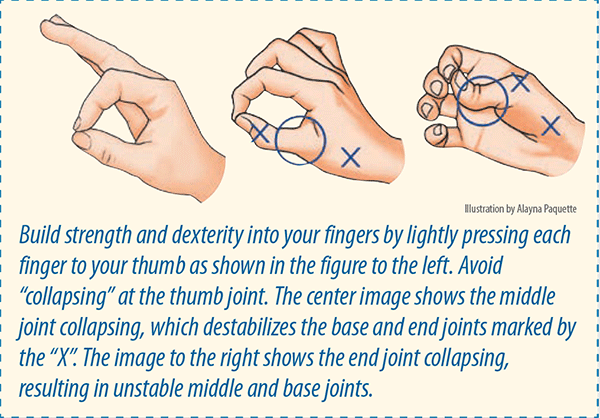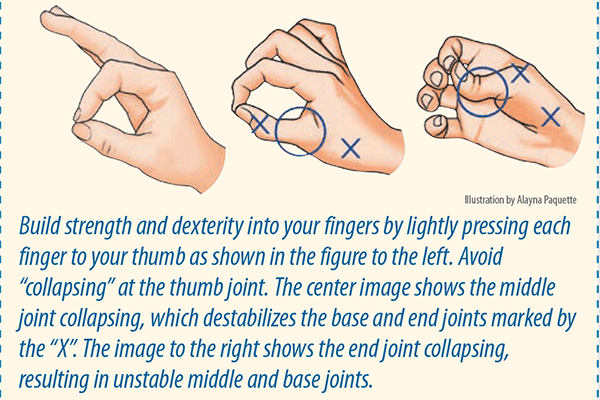Trouble Opening Jars?
Most people have a few tricks to remove tight jar lids—tapping the lid on a counter, running it under hot water, and smacking the bottom of the jar are common strategies. Sometimes these age-old tricks work quite well. Other times, people struggle and try to twist and force the jar open to no avail and end up with aching wrists and fingers. If you’re frequently frustrated by daily tasks that require fine motor skills (e.g., zipping jackets, turning door knobs, twisting a screwdriver), it may be time to see an occupational therapist (OT) who specializes in hand therapy.
“Pain is your body’s way of telling you you’re doing something the wrong way or you’re not strong enough to perform the task,” says hand therapist Rebecca Grantham, OT, UCLA Medical Center. “It’s best to be proactive and get it checked out to prevent it from getting worse.”
WHAT YOU CAN DO
OXO Good Grips and electric jar and can openers can be helpful kitchen devices. UCLA hand therapist Rebecca Grantham also recommends that you:
- Use a padded steering wheel cover to decrease the amount of strength needed to maneuver wheel.
- Wear gloves for gardening or household chores to protect hands and to decrease grip strength needed to complete the task
- Use spring-loaded scissors for a better grip with less force on your hand–have two pairs, one dedicated for food and another for general use.
- Use a large-handled brush to wash dishes instead of a sponge.
Causes of Pain and Weakness
The wrists and hands are among the most complex structures in the body. Joints are where bones come together, and there are lots of them in the hands. The wrist, for example, has not just one joint but is composed of several small joints. Each finger has three joints. At each joint juncture, the surface of bones is covered with cartilage, which allows them to glide smoothly during movement. Muscles, tendons, and ligaments support joints and enable a wide range of movement, from playing the piano to snapping your fingers. Any of the structures can be impacted by injury and/or disease, the most common being osteoarthritis (OA). Typically described as a “wear and tear” condition, OA is the most common type of arthritis and becomes increasingly common with age. The distinguishing characteristic of OA is the breakdown of cartilage that surrounds the joints. Pain at the base of the thumb, difficulty bending a finger, and weakness in hands/wrists are a few signs of OA. Other symptoms include:
- Pain that comes, goes, and gets worse with heavy use
- Stiffness/restricted range of motion
- Swelling, redness in fingers
- Bony knots on the fingers
- Difficulty holding objects
It’s time to see a doctor when any of these symptoms interfere with your daily life. The doctor will take your medical history and conduct a physical exam. That’s often all that’s needed to make an OA diagnosis. Carpal tunnel syndrome and other nerve compressions can also cause hand dysfunction, pain, numbness, and tingling. Sometimes additional tests may therefore be needed.
OA treatment typically involves resting the affected joints. Heat and/or ice applications can help, as can over-the-counter medications to relieve pain and inflammation (e.g., aspirin, ibuprofen, and naproxen). Joint protection (and education about it) is a huge part of OA treatment, as is learning to use adaptive tools. Exercises, when done correctly, can restore better function and may slow further deterioration.
“Sometimes, muscles are strong, but a patient doesn’t know how to recruit them,” explains Grantham. “Often, there is also a muscle imbalance. A hand therapist can help patients restore muscle balance and properly reactivate muscles.”
Beware the Ball Squeeze
Hand strengthening is a good idea, but just squeezing a ball may not be. “Typically, patients squeeze a ball, but their joints collapse and that aggravates the problem,” explains Grantham. “Some may not have pain yet, but over time squeezing or gripping with collapsed joints can cause excess wear and tear.”
See the illustrations (below) to get a better understanding of what a “collapsed joint” looks like and avoid the positions. In addition to helping you exercise correctly for your particular needs, an OT specializing in hand therapy is an expert at providing education on joint protection and recommending assistive devices that make your daily tasks and desired physical activities easier.

The post Trouble Opening Jars? appeared first on University Health News.
Read Original Article: Trouble Opening Jars? »
Powered by WPeMatico


